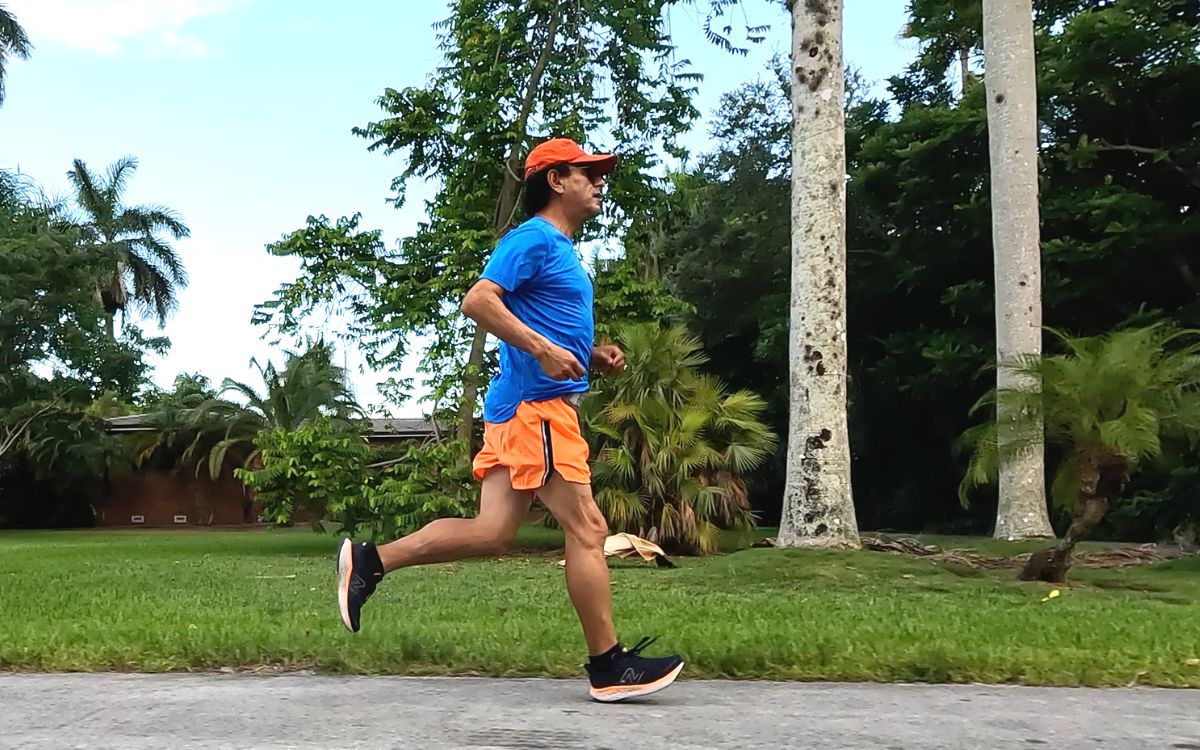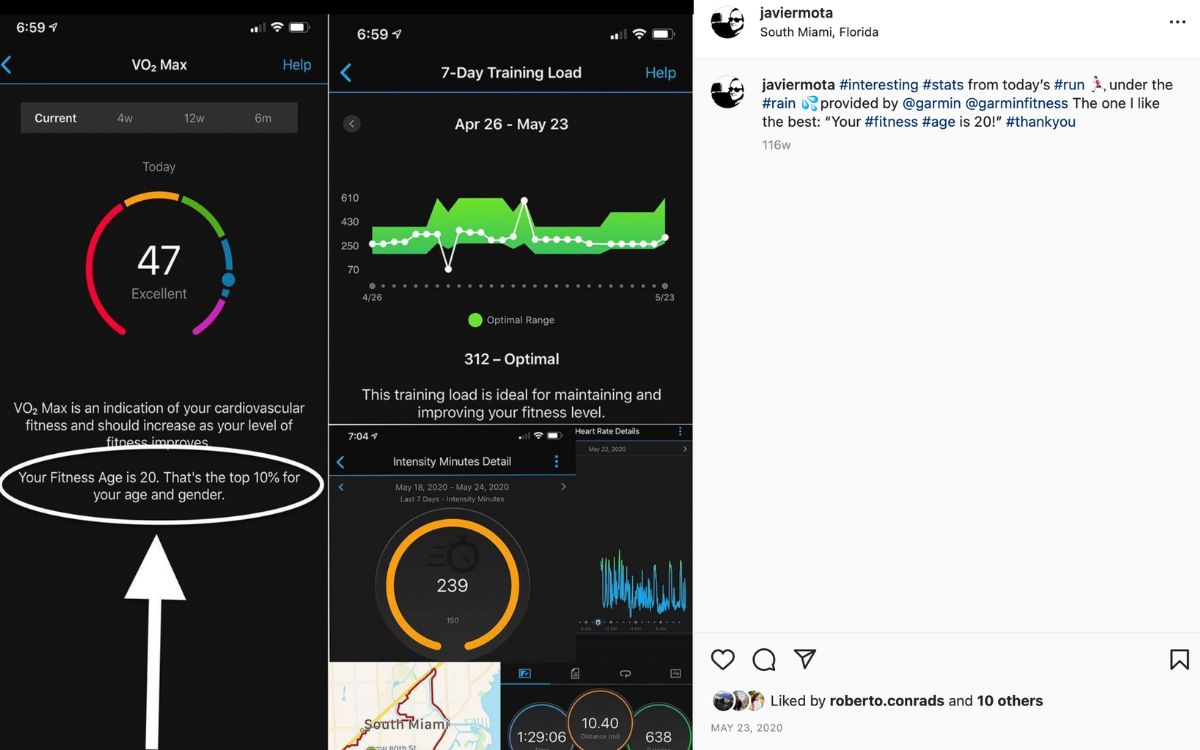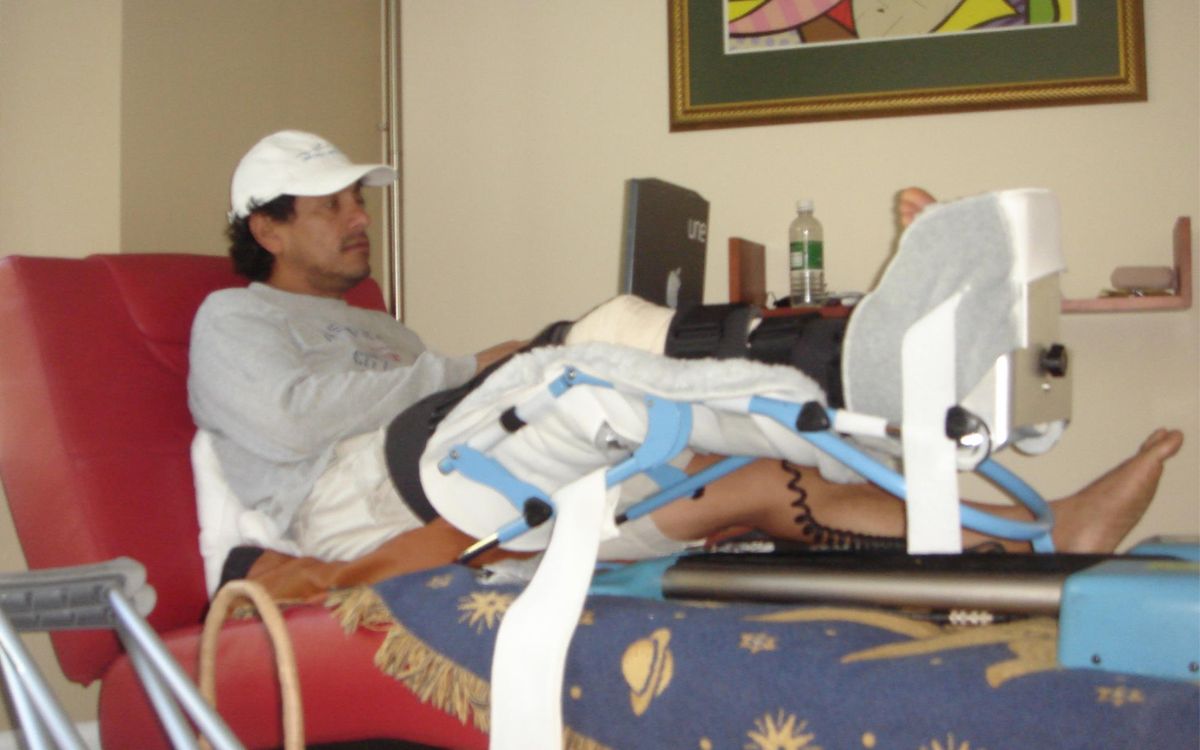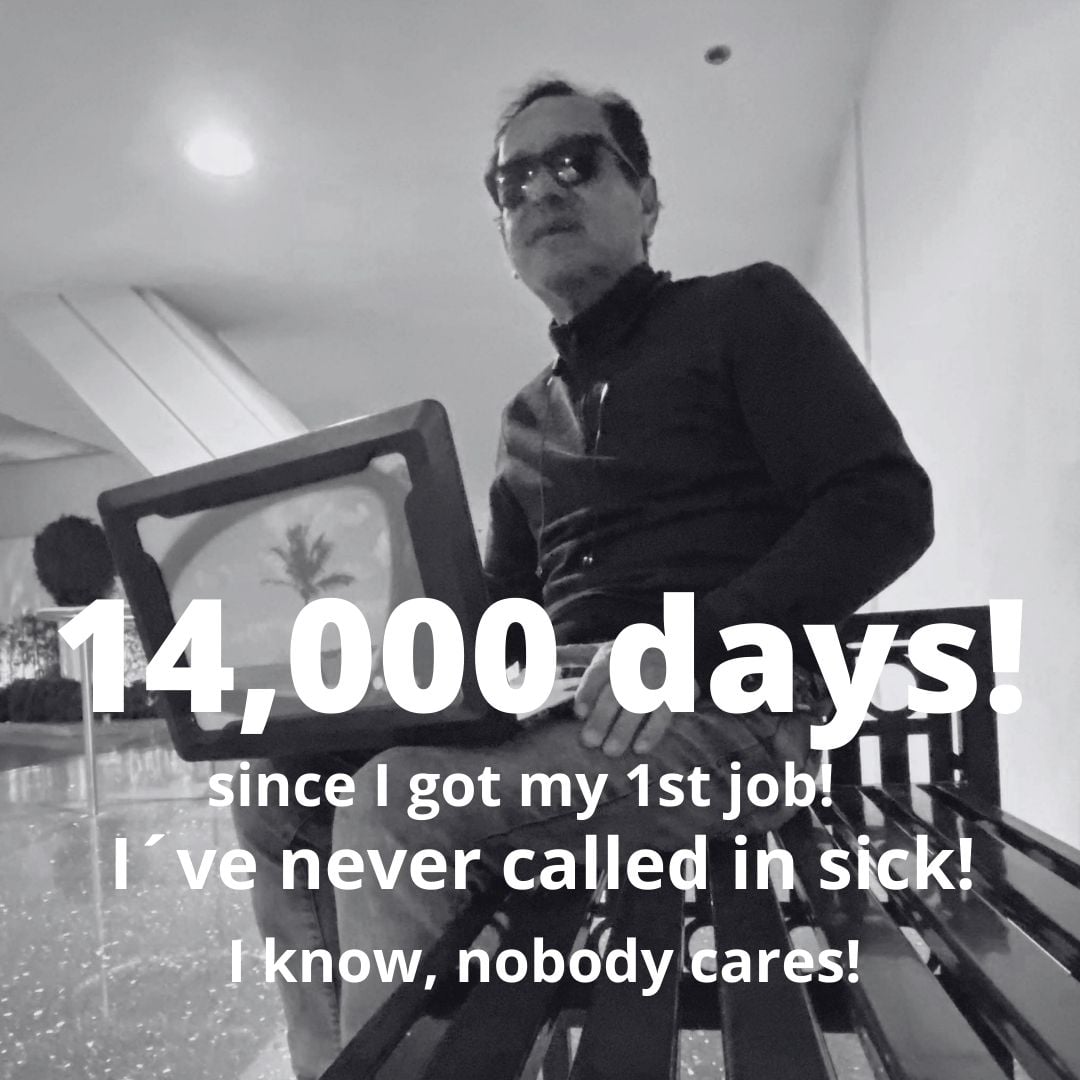First of all, I have to say that I don’t consider myself a true runner. I just run every day. There’s a difference.
A lot of people have told me that anyone who runs everyday for 2 years IS a runner, but I cook everyday too, and I am not a Chef; I play the guitar almost everyday and, most definitely, I am not a guitar player. You get the idea.
I don’t warm up, I don’t stretch, I am not training for anything, I don’t like to participate in organized races – I have only done one official 5K in my life-, I have not really improved my times or distance in the past 2 years.

In fact, I would say that I don’t like running. It’s boring, but I really appreciate what happens when you run … every day, for 2 years. You sleep better, you work better, you can eat and drink more.
For me, the best part is the challenge itself; planning ahead of every run and new goal.
Soccer on the other hand (or foot), I loved, but I was not a soccer player either.
I played since I could walk, but I never got good at it either. That’s why I played at every position possible, not because of my skills, but just to get a chance to get in the game. Nine fractured bones, 3 knee surgeries – 2 meniscus and 1 meniscus plus torn ACL, a severely dislocated shoulder and countless other minor injuries later, I stopped playing at an organized level at the end of 2012.
That’s when I dislocated the left shoulder at one of my last soccer games. I was playing in a 30-and-under-league at age 50 – or, as someone told me then, being stupid -, and I was also training to run the Miami Half Marathon.

On Sunday, November, 25th, 2012 I ran 10.18 miles in 1 hour, 49 minutes, and 58 seconds (10:48 minutes per mile pace), with no issues. The 13.1 miles for the half marathon seemed doable, but after the shoulder dislocation the next week, I stopped everything. No running, no soccer, no exercise at all for a whole year.
Then, on Sunday, December, 22, 2013, I woke up and decided to go for a run: 6.01 miles at 8:55 minutes per mile pace. Again, no warm up, no stretching, no training. I just woke up and went.
I didn´t run again until Thursday, July 10, 2014 (3.34 miles at 10:46 minutes a mile pace) and took a 3 year break. On Tuesday, September, 16h, 2017, I did 2.09 miles at 11:07 miles per minute.
Since then, I started to be more consistent with at least 1 run a week and an occasional informal soccer game. I never learned my lessons!
Then 2020 happened.
The start line for the streak
Because of my job as an automotive journalist, I travel pretty much every week – I was on the road for 320 days in 2019 -, so when we were locked down because of COVID, I started to run more often at home. I did 18 runs in June, 2020 for a total of 77.83 miles.
That’s when I was invited to join the private Facebook Automotive Industry Ragnar Relay Interest Group for a 500 mile challenge in 2 weeks. It sounds like a lot, but it wasn´t: 12 runners, 14 days, 3 miles a day each. We did it!
And then what? After a couple of days off, I added an individual challenge to keep running the rest of July, which I did (127.7 miles), and then August … under the Miami summer heat! I survived with a total of 110.9 miles, for the official start of the current streak.
The next challenge became 100 days in a row, which I achieved in October, 2020 and then, to finish the year with consecutive runs every day. After that I have not found a reason to stop.
The work trips slowly restarted in 2021 and with that, the real challenge has been finding the time and conditions to keep running every day.
I have run in 6 countries and over 50 cities, starting as early as 5 AM and as late as 11:45 PM; at 30F degrees under the snow in Ankara, Turkey, and at 120F in Austin, Texas. I once jumped out of the car at 11 PM on my way home from the airport to run the last 3 miles, just to keep the streak going.
The longest run – almost 9.5 miles- was in Munich, Germany, last September, just because I got lost and ran the last 5 miles in record time, afraid that I was going to miss the start of my work assignment. The fastest: a 10K at 7:58 minute per-mile pace at home. It was a surprise even for me.
I´ve been invited to run a marathon, but now I wouldn’t even consider a half. I think that running long distances creates a higher risk of getting injured. I´ve heard from people who say they regret not stopping running after a certain age (around 50), because of all of the injuries and long lasting effects on the knees and hips. Yes, all of them used to run marathons and are overweight.
I run until … I won´t

There´s never been a day that I didn’t feel like running, despite lack of sleep, occasional hangovers and always some kind of pain: from the left shoulder, which has not been fully repaired from the dislocation now more than 10 years ago, to lower back spasms and slow 3-day recovery after a soccer game last February; regular field, 90 minutes, and a total of 6 miles of running during the game, after 2 running to get to the field.
I haven’t had a full medical check-up during the streak, but I donated blood twice, got the COVID-19 vaccine and boosters and, as far as I know, I have not gotten infected, despite getting back to travel every week.
I’ve also been told that I should wear proper running shoes – I am flat footed -, but until late May, when I got a pair of New Balance Fresh Foam 1080 shoes, I ran with all brands and styles and didn’t feel any difference.
And then, there’s the issue about how long I should keep running on old shoes. For me, it’s until I see enough holes either in the top or bottom.
I don’t know any better, I am not a runner. I just run every day.
Next challenge: keep my Vo2MAX at “superior level” (52) and my “Fitness age at 20” – per my Garmin Fenix 5 Plus -, until I turn 60, which is next December.
After that I am sure I will find a new challenge, a new streak, because, when I think about it, I´ve been doing that all my life.
I starting my first job as a journalist on Thursday, January 13, 1983 and I´ve never missed a day of work since; I covered the 162 games of the inaugural season of the then Florida Marlins in 1993 and then 5 full seasons until they won their first World Series in 1997 then; I´ve never been back to a whole baseball game since. That´s a much longer streak
Some people might conclude that I am more stubborn than determined or good at anything. They might be right.
So, for now, I will just keep running everyday, until, one day, I won´t.
Now, listen to the experts

Since I think I am going to keep going for the near future, I got the opinion of a couple of people who really know about running and health care to learn about some of the issues mentioned.
Like Certified Running Coach (RRCA), Level II – Adolfo Salgueiro:
If you run, you are a runner. You may not be a competitive runner, but that is another issue.
Like Bart Yasso said, “I’ve never met a fake runner”. I think you are mistaking all the activities you are mentioning as being good/great at it. We can’t all be Eliud Kipchoges at running, or Todd English at cooking, or Brian Mays at playing guitar. Those are the exceptions, not the rules.
Shoes are more important than you give them credit for. Once the outer sole wears off in any part of the shoe, it is time to change it. They usually last from 300-350 miles. The best way to figure out what shoe is good for you is to go to a running store, where you have a runner fitting you, not a teenager trying to get a commission.
A watch cannot measure VO2Max. This is not measured by an equation. VO2MAX is the amount of oxygen your body can consume at maximum effort. This gets measured by a machine that quantifies the O2 that goes in and the O2 that comes out. The difference is the O2 you consume. Unless your watch is connected to this machine, it can’t measure it. Also, VO2Max is good to know but it is not the parameter that will measure everything for you. And, if you are not training for a run or performance, it shouldn’t even matter.
How risky is it to run everyday?
There is a universal answer to this question: It depends.
Running every day is not necessarily risky per se, but it is not for everybody either. A running streak could be a nice challenge for certain runners and could be a road to injury for others. The key is to make sure you are recovered properly in between runs and that you adjust each run to the state of your body so you don’t overtax it.
There are many confirmed 20+ year streaks. It is said the longest one was over 50 years, but I am not sure how that can be confirmed beyond the honor system considering there was no technology to verify it.
There are clubs for streakers. You can check this website.

Do you recommend it?
The key is not to become a prisoner of the streak. When you go beyond your limits only because you don’t want to break the streak, you are edging towards the possibility of an injury. Most running injuries are because of overuse and repetitive movement so, if you don’t allow your body to recover because you must run regardless, you are asking for trouble.
Personally, I’ve never been inclined to try a streak, but that only means it is not attractive to me, not that it shouldn’t be done. If a streak is for you, be smart about it, keep it going as long as it doesn’t become a chore and, most important: don’t be afraid to break it and start a new one if it is necessary. Nobody is going to love you any less because you didn’t run one day.
How important is resting-recovery? How long in between runs?
It depends. Not everybody recovers at the same rate. Being ready to run tomorrow after an easy 3-miler on a cool spring morning is very different from doing so if you pushed for 20 miles under the sun. Also, age, weather, nutrition, health, sleep and fitness, among others, are factors that will determine whether you are ready to go again tomorrow or not.
Recovery doesn’t necessarily mean to take a day or two or a week off. It is an individual parameter that every runner needs to find out what works for them. The main thing to understand is that training consists of two equally important elements: Work and recovery.
Does distance running create more risk for injuries?
Just by moving around we are subject to injuries. I have read stats that 50% of runners get injured every year and that 90% will get injured during their lifetime. I don’t have the source of these at hand right now, but regardless of how accurate they are, they show you that you must prepare your body for the task at hand.
Cross training, dynamic stretching, weightlifting, cycling and/or yoga, are just a few of the activities that will help you counterbalance the effects of running in your body. To become a lifetime runner, I believe you should do something other than just running.
Unless you have an underlying health issue or a structural problem in your body, most people can finish a 5K or a 10K race if they commit to it. Beyond that, there are millions of people who run half marathons, marathons and ultra-marathons. So, it is a matter of preparing your body for what you want to accomplish and being smart about figuring out what your limits are.
Running a marathon without training is possible, sure, but you will go through hell and, if you are lucky not to get injured, it will take you a while to recover.
This only means you can run a marathon without training, not that you are fit to run a marathon. Same applies to every distance. You must prepare your body for what it is about to undertake.
If you do so and you recover properly so you can do it again, you could keep running until the day you die.
Scott Lang MD, Professor of Family Medicine – UCF College of Medicine

The Human body is a perfectly designed system for the following three activities: locomotion, food acquisition, and sex.
Sedentarism is by far more dangerous from an overall health perspective than is running everyday. The truth of the matter is most people are deconditioned prior to deciding that they want to be daily “runners”.
They then «flip the switch» and all of a sudden begin running on hard surfaces at the precise rate of TOO FAR-TOO FAST-TOO SOON.
This population of people is at risk for overuse injuries which is the risk I assume you are alluding to.
Preventing these overuse injuries there are a few principles which every athlete at any stage must follow.
Number 1: Start low low, and go slow. Way slower and way lower than you think you need to.
Number 2: Do not increase your running mileage by more than 10% per week.
Number 3: Do not run more than 45 miles per week. There is no evidence that I see that running more than 45 miles per week improves performance or overall health, but there’s a great deal of evidence that running more than 45 miles per week puts you at risk for an overuse injury.
Number 4: The best running surfaces are soft and flat.
Number 5: Do not «run through pain”. If you have muscle or joint pain when your run, ice and rest up. If the pain persists for more than a week, go see your doctor.
Number 6: Follow any perceivably «hard training days» with easy days. That doesn’t mean you have to sit on your couch and eat Haagen Daaz, but have a perceivably easy day, and try not to have two “hard» training days doing the same activity two days in a row.
Number 7: Get new shoes every 500 miles. These rules are not perfect, but they work for the majority of new athletes.

Smart watches are perfectly accurate at calculating your heart rate
They can do so with precision and accuracy. Anything else that comes out of your smart watch is a vague calculation based on a flawed formula and is ultimately inaccurate.
Without getting too deep into the details, in order to calculate a true VO2Max, you would have to be set up on a treadmill or a bike with a mask over your face and take someone through a vigorous exercise protocol calculating O2 consumption and co2 production during maximal exercise via the attached mask.
Your watch does not do that. I dont have any idea how a “fitness age” is calculated, but it sure sounds like a marketing tool. Maybe you can enlighten me?
Moderate Exercise every day is an amazing and miraculous medicine
It helps prevent heart attacks and strokes by improving nearly every metabolic risk factor: lowering blood pressure, lowering cholesterol, decreasing the incidence that you’ll develop diabetes over your lifetime, developing healthy strong bones and muscles as you age, and serving as a perfectly effective medicine in both the treatment and prevention of anxiety and depression.
The risk of Exercise gets slightly more dangerous at the extreme end of the spectrum and when done compulsively, but that is a nuanced discussion for another time and purpose.
End story, for the overwhelming majority of humans alive today, exercise is a positively transformational medicine that should be practiced to optimize one’s healthspan and lifespan.
Español
Si quieres correr todos los días durante 2 años, no sigas mi ejemplo; mejor, hazle caso a los expertos
En primer lugar, tengo que decir que no me considero un verdadero corredor. Solo corro todos los días. Hay una diferencia.
Mucha gente me ha dicho que cualquier persona que corre todos los días durante 2 años es un corredor, pero yo también cocino todos los días y no soy Chef; toco la guitarra casi todos los días y, definitivamente, no soy guitarrista. ¿Entiendes la idea?
No hago calentamiento, no estiro, no estoy entrenando para nada, no me gusta participar en carreras organizadas – solo he hecho un 5K oficial en mi vida -, no he mejorado mucho mis tiempos o distancia en los últimos 2 años.
De hecho, diría que no me gusta correr. Es aburrido, pero realmente aprecio los beneficios cuando corres … todos los días, durante 2 años; duermes mejor, trabajas mejor, puedes comer y beber más.
Para mí, la mejor parte en esta racha es el desafío en sí mismo; planear antes de cada carrera y cada nuevo objetivo.
El fútbol en cambio, me encantaba, pero tampoco fui un verdadero futbolista.
Jugué desde que podía caminar, pero tampoco lo hice bien. Es por eso que jugué en todas las posiciones posibles, no por mis habilidades, sino solo para tener la oportunidad de entrar en el juego.

Nueve huesos fracturados, 3 cirugías de rodilla – dos de meniscos y una de menisco más el ligamento anterior cruzado desgarrado, un hombro severamente dislocado y un sinnúmero de otras lesiones menores más tarde, dejé de jugar en un nivel organizado a fines de 2012.
Fue entonces cuando me disloqué el hombro izquierdo en uno de mis últimos partidos de fútbol. Estaba jugando en una liga de menores de 30 años a mis 50, o, como alguien me dijo entonces, siendo estúpido. También estaba entrenando para correr el Medio Maratón de Miami a principios de 2013.
El domingo 25 de noviembre de 2012 corrí 10,18 millas en 1 hora, 49 minutos y 58 segundos (ritmo de 10:48 minutos por milla), sin problemas. Las 13.1 millas para la media maratón parecían factibles, pero después de la dislocación del hombro la semana siguiente, detuve todo. Nada de correr, nada de fútbol, nada de ejercicio durante todo un año.
Entonces, el domingo 22 de diciembre de 2013, me desperté y decidí salir a correr: 6,01 millas a un ritmo de 8:55 minutos por milla. Nuevamente, sin calentamiento, sin estiramiento, sin entrenamiento. Simplemente desperté y salí a correr.
No lo volví a hacer hasta el jueves 10 de julio de 2014 (3,34 millas a 10:46 minutos por milla) y luego me tomé un descanso de 3 años. El martes 16 de septiembre de 2017 hice 2,09 millas a 11:07 millas por minuto.
Desde entonces, comencé a ser más constante con al menos 1 carrera a la semana y ocasionalmente un partido informal de fútbol. ¡Nunca aprendí la lección!
Y entonces llegó el 2020.
El inicio de la racha

Debido a mi trabajo como periodista automotriz, viajo casi todas las semanas (estuve de viaje de trabajo 320 de los 365 días en 2019), así que cuando me quedé encerrado debido a la pandemia del COVID, comencé a correr más a menudo en casa. Hice 18 salidas en junio de 2020 para un total de 77.83 millas.
Fue entonces cuando me invitaron a unirme al grupo privado Automotive Industry Ragnar Relay Interest Group en Facebook para un challenge de 500 millas en 2 semanas a partir del fin de semana del 4 de julio. Suena como mucho, pero no lo fue: 12 corredores, 14 días, 3 millas diarias cada uno. ¡Lo hicimos!
¿Y ahora qué? Después de un par de días libres agregué un desafío individual para seguir corriendo el resto de Julio (127.7 millas) para el inicio oficial de la racha actual. Luego agosto … ¡bajo el calor del verano de Miami! Sobreviví con un total de 110.9 millas.
El próximo desafío se convirtió en 100 días seguidos, lo cual logré en octubre de 2020 y luego, terminar el año con corridas consecutivas todos los días.
Después de eso no he encontrado una razón para parar.
Los viajes de trabajo se reiniciaron lentamente en 2021 y con eso, el verdadero desafío ha sido encontrar el tiempo y las condiciones para seguir corriendo todos los días.
He corrido en 6 países y más de 50 ciudades, arrancando desde antes de las 5 de la mañana y tan tarde como las 11:45 de la noche; a 30 grados F bajo la nieve en Ankara, Turquía, y a 120 F en Austin, Texas. Una vez me bajé del auto a las 11 de la noche camino a casa desde el aeropuerto para correr las últimas 3 millas, sólo para mantener viva la racha.
La carrera más larga – casi 9.5 millas, fue en Munich, Alemania-, en septiembre pasado, solo porque me perdí y corrí las últimas 5 millas en un tiempo récord, por el miedo de perderme el comienzo de mi asignación de trabajo.
La carrera más rápida: un 10K en Miami, a ritmo de 7:58 minutos por milla. Fue una sorpresa incluso para mí.
Me han invitado a correr una maratón, pero ahora ni siquiera consideraría un medio.
Creo que correr largas distancias crea un mayor riesgo de lesionarse. He escuchado de amigos que dicen que se arrepienten de no haber dejado de correr después de cierta edad (alrededor de los 50), debido a todas las lesiones y efectos permanentes en las rodillas y las caderas. Sí, todos solían correr maratones y tenían sobrepeso.

Correré hasta que … no lo haga más
No ha habido un día que no tuviera ganas de salir a correr a pesar de la falta de sueño, las ocasionales resacas y siempre algún tipo de dolor: desde el hombro izquierdo, que no ha sido reparado del todo por la luxación de hace ahora más de 10 años, hasta espasmos en la parte inferior de la espalda y la lenta recuperación de 3 días después de un partido de fútbol en febrero pasado en un campo regular, 90 minutos y un total de 6 millas de carrera durante el juego, después de 2 corriendo para llegar a la cancha.
No me he hecho una revisión médica completa durante la racha, pero he donado sangre dos veces, me he puesto la vacuna y los refuerzos contra el COVID-19 y, que yo sepa, no me he contagiado a pesar de volver a viajar todas las semanas.
También me han dicho que debo usar zapatillas adecuadas para correr -tengo pies planos-, pero hasta finales de mayo, cuando recibí un par de New Balance Fresh Foam 1080, corría con todas las marcas y estilos, y no sentía diferencia alguna.
Y luego, está la cuestión de cuánto tiempo debo seguir corriendo con zapatillas viejas. Para mí, es hasta que veo suficientes agujeros en la parte superior o en la suela. Qué sé yo de eso. No soy un corredor. Solo corro todos los días.
Próximo reto: mantener mi Vo2MAX en “nivel superior” (52) y mi “Edad Fitness a los 20 años” -según mi Garmin Fenix 5 Plus-, hasta cumplir 60 en diciembre.
Después de eso, estoy seguro de que encontraré un nuevo desafío, una nueva racha, porque cuando lo pienso, he estado haciendo eso toda mi vida.
Comencé mi primer trabajo como periodista el jueves 13 de enero de 1983 y desde entonces nunca he perdido un día de trabajo; cubrí los 162 juegos de la temporada inaugural de los entonces Florida Marlins en 1993 y luego 5 temporadas completas hasta que ganaron su primera Serie Mundial en 1997. Desde entonces nunca he vuelto a un juego de béisbol completo. Esa es una racha mucho más larga.

Algunos pueden llegar a la conclusión de que soy más terco que determinado, pero no lo suficiente bueno para nada en particular. Puede que tengan razón.
Entonces, por ahora, seguiré corriendo todos los días, hasta que un día, no lo haga más.
Pero para seguir, conseguí la opinión de un par de expertos que realmente saben sobre el tema del deporte de correr y el cuidado de la salud a la hora de hacerlo.
Hazle caso a los expertos
Adolfo Salgueiro: Coach de Carreras Certificado (RRCA, Nivel II)
Si corres, eres un corredor. Puede que no seas un corredor competitivo, pero ese es otro tema.
Como dijo Bart Yasso: “Nunca conocí a un corredor falso”.
Creo que estás confundiendo todas las actividades que mencionas con el hecho de ser bueno o excelente en ellas.
No todos podemos ser Eliud Kipchoges corriendo, Todd English cocinando o Brian Mays tocando la guitarra. Ellos son las excepciones, no la regla.
Zapatos y relojes inteligentes

Los zapatos son más importantes de lo que les das crédito. Una vez que la suela se desgasta en alguna parte, es el momento de cambiarlos. Suelen durar entre 300 y 350 millas.
La mejor manera de averiguar qué zapato es bueno para ti es ir a una tienda especializada de atletismo, donde encuentres a un profesional que determine tu medida y estilo justos, no un vendedor adolescente que solo busca ganarse una comisión con cada venta.
Un reloj “inteligente” no puede medir el VO2Max. Esto no se mide con una ecuación científica.
El VO2MAX es la cantidad de oxígeno que tu cuerpo puede consumir con el máximo esfuerzo. Esto lo mide una máquina que cuantifica el oxígeno que entra y el que sale. La diferencia es la cantidad que consumes.
A menos que tu reloj esté conectado a esta máquina, no puede medir el VO2Max.
Es bueno saber el VO2Max, pero no es el parámetro que medirá todo por ti. Y, si no estás entrenando para una carrera, ni siquiera debería importarte.

¿Qué tan arriesgado es correr todos los días?
Hay una respuesta universal a esta pregunta: depende.
Correr todos los días no es necesariamente arriesgado per se, pero tampoco es algo para todo el mundo.
Una racha de carreras puede ser un buen reto para ciertos corredores, pero podría ser el camino hacia las lesiones para otros.
La clave es asegurarse de lograr una recuperación adecuada entre carreras y un ajuste en cada carrera con el estado de tu cuerpo para no sobrecargarlo.
Hay muchas rachas confirmadas de más de 20 años. Se dice que la más larga fue de más de 50 años, pero no estoy seguro de cómo se puede confirmar eso más allá del sistema de honor, considerando que no había tecnología para verificarlo.
Hay clubes para rachas. Puede consultar este sitio web.
¿Recomiendas hacer una racha?
La clave es no volverse prisionero de la racha.
Cuando vas más allá de tus límites sólo porque no quieres romper la racha, te estás acercando a la posibilidad de una lesión.
La mayoría de las lesiones por correr se deben al uso excesivo y al movimiento repetitivo, por lo que, si no permites que tu cuerpo se recupere porque debes correr para seguir la racha sí o sí, te estás buscando problemas.
Personalmente, nunca me he inclinado por probar una racha, pero eso solo significa que no me atrae, no que no se deba hacer.
Si una racha es para ti, sé inteligente al respecto, mantenla mientras no se convierta en una tarea y, lo más importante: no tengas miedo de romperla y comenzar una nueva si es necesario.
Nadie te va a querer menos porque no corriste un día.

¿Qué tan importante es el descanso-recuperación? ¿Cuánto tiempo entre carreras?
También depende. No todos se recuperan al mismo ritmo. Estar listo para correr mañana después de una fácil carrera de 3 millas en una fresca mañana de primavera es muy diferente a hacerlo si haces 20 millas bajo el sol.
Además, la edad, el clima, la nutrición, la salud, el sueño y el estado físico, entre otros, son factores que determinarán si estás listo para volver a correr o no mañana.
La recuperación no significa necesariamente tomarse un día o dos o una semana de descanso. Es un parámetro individual que cada corredor necesita para encontrar lo que funciona para ellos.
Lo principal a entender es que el entrenamiento consta de dos elementos igualmente importantes: Trabajo y recuperación.
¿Las carreras de distancia crean más riesgo de lesiones?
Con solo movernos estamos en riesgo de sufrir lesiones.
He leído estadísticas que indican que el 50% de los corredores se lesionan cada año y que el 90% se lesionarán durante su vida. No tengo la fuente de estos a mano, pero independientemente de cuán precisos sean, esos datos te muestran que debes preparar tu cuerpo para la tarea que tienes en mente.
El cross training –estiramientos dinámicos, levantamiento de pesas, ciclismo y/o yoga -, son solo algunas de las actividades que te ayudarán a contrarrestar los efectos del running en tu cuerpo.
Para convertirte en un corredor de por vida, debes hacer algo más que correr.
A menos que tengas un problema de salud subyacente o un problema estructural en el cuerpo, la mayoría de las personas pueden terminar un 5K o un 10K si se comprometen a hacerlo.Más allá de eso, hay millones de personas que corren medias maratones, maratones y ultramaratones.
Por lo tanto, se trata de preparar tu cuerpo para lo que quieres lograr y ser inteligente para descubrir cuáles son tus límites.
Correr una maratón sin entrenar es posible, pero sufrirás un infierno y, si tienes suerte de no lesionarte, te llevará un tiempo recuperarte. Esto solo significa que puedes correr un maratón sin entrenamiento, no que estés en condiciones de correr un maratón.
Lo mismo se aplica a todas las distancias. Debes preparar tu cuerpo para lo que está a punto de emprender.
Si lo haces y te recuperas adecuadamente para poder volver a hacerlo, podrías seguir corriendo hasta el día de tu muerte.

Y ahora el punto de vista médico
Scott Lang MD, Profesor de Medicina Familiar – UCF College of Medicine
El cuerpo humano es un sistema perfectamente diseñado para las siguientes tres actividades: locomoción, adquisición de alimentos y sexo.
El sedentarismo es mucho más peligroso desde una perspectiva de salud general que lo que ocurre todos los días.
La verdad es que la mayoría de las personas no están en condiciones antes de decidir que quieren ser «corredores de todos los días».
Luego prenden el switch y, de repente, comienzan a correr sobre superficies duras a la velocidad precisa de DEMASIADO-DEMASIADO RÁPIDO-DEMASIADO PRONTO.
Estas personas corren el riesgo de sufrir lesiones por uso excesivo.
Para prevenir estas lesiones hay algunos principios básicos que todo atleta en cualquier etapa debe seguir.
1: Comienza de a poco y ve despacio. Mucho más lento y mucho menos distancia de lo que crees que puedes.
2: No aumentes la distancia de carrera en más del 10% por semana.
3: No corras más de 45 millas por semana. No hay evidencia de que correr más de 45 millas por semana mejore el rendimiento o la salud en general, pero hay una gran cantidad de evidencia de que correr más de 45 millas por semana te pone en riesgo de sufrir una lesión por uso excesivo.
4: Las mejores superficies para correr son suaves y planas.
5: Nunca corras con dolor. Si tienes dolor muscular o articular cuando corres, ponte hielo y descansa. Si el dolor persiste por más de una semana, ve a ver a tu médico.
6: Después de cualquier «día de entrenamiento duro”, programa días fáciles para recuperarte. Eso no significa que tengas que sentarte en tu sofá y comer Haagen Daaz, sino tener un día perceptiblemente fácil y tratar de no tener dos días de entrenamiento «duro» haciendo la misma actividad dos días seguidos.
7: Usa zapatos nuevos cada 500 millas. Estas reglas no son perfectas, pero funcionan para la mayoría de los atletas nuevos.

Relojes inteligentes
Los relojes inteligentes son perfectamente precisos para calcular tu frecuencia cardíaca. Pueden hacerlo con precisión y exactitud. Cualquier otra cosa que salga de tu reloj inteligente es un cálculo vago, basado en una fórmula defectuosa y, en última instancia, inexacta.
Sin profundizar demasiado en los detalles, para calcular tu verdadero VO2Max, tendrías que estar en una cinta de correr o en una bicicleta fija con una máscara sobre la cara y llevar a alguien a través de un protocolo de ejercicio vigoroso que calcule el consumo de oxígeno y la producción de CO2 durante ejercicio máximo, a través de la máscara adjunta.
Tu reloj no hace eso. No tengo idea de cómo se calcula una «edad fitness», pero seguro que suena como una herramienta de marketing. ¿Tal vez alguien podría iluminarme en esto?

El ejercicio moderado todos los días es una medicina asombrosa y milagrosa
Ayuda a prevenir ataques cardíacos y accidentes cerebrovasculares al mejorar casi todos los factores de riesgo metabólicos: reducir la presión arterial, reducir el colesterol, disminuir la incidencia de diabetes a lo largo de su vida, desarrollar huesos y músculos sanos y fuertes con la edad y servir como un remedio perfectamente eficaz. Es una medicina tanto en el tratamiento, como en la prevención de la ansiedad y la depresión.
El riesgo del ejercicio se vuelve un poco más alto en el extremo del espectro y cuando se hace compulsivamente, pero esa es una discusión matizada para otro momento y propósito.
Así que para la gran mayoría de los seres humanos, el ejercicio es una medicina positivamente transformadora que debe practicarse para optimizar la vida y la salud.




